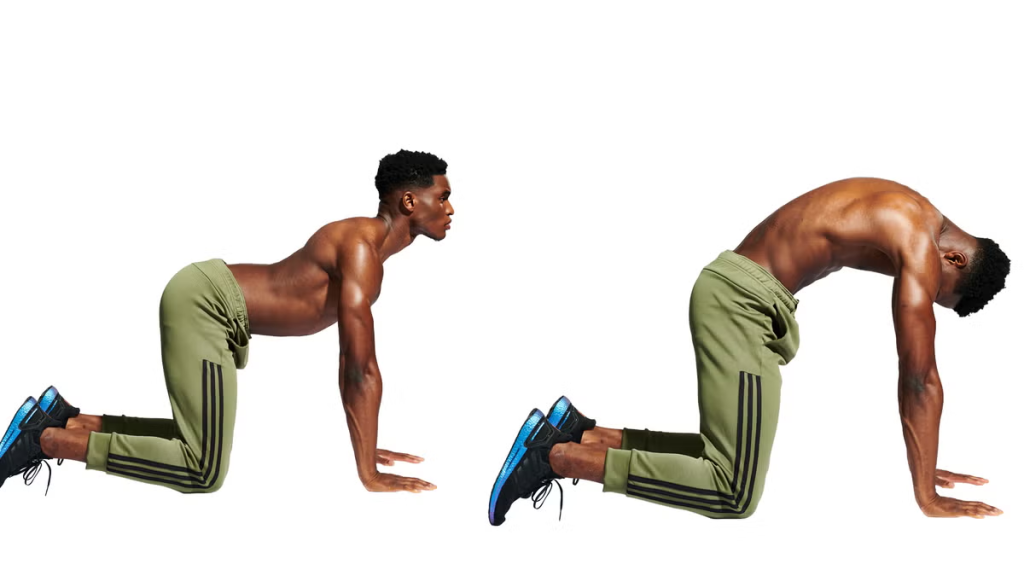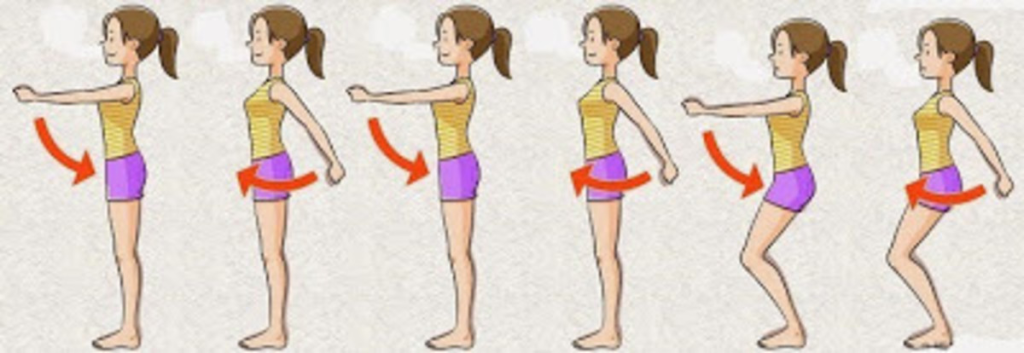Ever Wondered Why You Wake Up Achy—Even Before Sitting at Your Desk?
It’s not just about sitting for long hours. Poor posture often starts before the workday begins. Tight hips, stiff shoulders, and an aching lower back? These aren’t just side effects of sitting—they’re the aftermath of how you start your morning. The good news? A quick morning posture routine at home can set your entire day straight—literally.
Did You Know?
People with poor posture are more likely to experience fatigue by noon than those who incorporate posture-correcting movement in the morning.
This guide walks you through a targeted, research-backed morning routine for desk workers designed to reset your spine, activate your core, and loosen the muscles that tend to lock up when you sit for hours. Let’s dive in.

What Can Happen After 30 Days of This Morning Exercise Routine
| Benefit | What You’ll Notice |
|---|---|
| Improved Posture | Shoulders naturally stay back, spine feels aligned, reduced slouching at your desk |
| Less Aches & Stiffness | Morning back and neck pain significantly reduced; joints feel more mobile |
| Stronger Core & Glutes | You’ll feel more stable while sitting and standing; lower back strain decreases |
| Better Breathing | Deeper, fuller breaths as chest and diaphragm expand more freely |
| More Energy & Focus | Less fatigue by mid-morning; mental clarity improves due to better oxygen flow |
| Increased Flexibility | Hips, shoulders, and spine become more fluid, making everyday movements easier |
| Fewer Headaches | Tension-related headaches from poor posture become less frequent or disappear |
| Confidence Boost | Upright posture can improve your self-image and how others perceive your presence |
| Positive Habit Formation | Starts your day with intention, setting a healthier tone for work and productivity |
Why Desk Workers Struggle With Posture
Prolonged sitting puts excessive stress on your spine, shoulders, and hips. Over time, this leads to:
- Rounded shoulders
- Forward head posture
- Tight hip flexors
- Weak glutes and core muscles
All these factors can cause chronic back pain, reduced breathing capacity, and even affect your mental alertness. But there’s a powerful fix you can start before your first email of the day.
The Morning Posture Reset Routine (Takes Just 10–15 Minutes)
These exercises are designed to be low-impact and effective, even if you’re still in your pajamas. No equipment needed.
1. Cat-Cow Stretch (1 minute)
Targets: Spine mobility, core activation

- Start on all fours with a neutral spine.
- Inhale, arch your back, lift your head and tailbone (cow).
- Exhale, round your spine, tucking your chin and pelvis (cat).
- Repeat slowly for 1 minute.
Myth Buster: Many people believe back pain comes from weak back muscles. In truth, tight hips and a rigid spine are often the culprits.
2. Standing Wall Angels (2 minutes)
Targets: Upper back, shoulder mobility

- Stand against a wall, feet 6 inches out, back and head flat to the wall.
- Raise arms to form a “W,” then slide them up into a “Y” shape.
- Keep contact with the wall throughout.
- 2 sets of 10 reps.
Tip: This reverses the effects of hunching over your screen for hours.
3. Hip Flexor Stretch (Each Side: 1 minute)
Targets: Tight hips, posture alignment

- Kneel with your right knee on the floor, left foot in front at 90°.
- Gently push hips forward until you feel a stretch in the right hip.
- Hold for 1 minute each side.
4. Glute Bridges (2 minutes)
Targets: Glutes, lower back support

- Lie on your back, knees bent, feet flat on the floor.
- Press through your heels and lift your hips.
- Squeeze glutes at the top.
- Lower down slowly.
- 3 sets of 10 reps.
Interesting Fact: Weak glutes can cause your lower back to overcompensate, leading to pain even while sitting.
5. Chin Tucks (1 minute)
Targets: Forward head posture

- Sit or stand tall.
- Tuck your chin in as if making a double chin.
- Hold for 5 seconds, then release.
- Repeat 10–12 times.
6. Standing Arm Swings (1–2 minutes)
Targets: Circulation, posture awareness

- Stand with feet shoulder-width apart.
- Gently swing arms front to back, letting shoulders move freely.
- Do this for 1–2 minutes to boost blood flow and shoulder mobility.
Breathing Check-In: Diaphragmatic Breathing (1 minute)
Poor posture compresses your lungs, making breathing shallow. Take a moment to breathe deeply from the belly.

- Sit upright or lie down.
- Inhale through the nose for 4 seconds, letting your belly expand.
- Exhale through the mouth for 6 seconds.
- Repeat for 1 minute.
Do You Know?
Deep breathing enhances posture by activating your core stabilizers—muscles that support your spine throughout the day.
Why This Routine Works (Science-Backed Benefits)
- Improves spinal alignment by increasing mobility and muscle balance
- Activates key muscles like the glutes and core, reducing strain on the lower back
- Boosts circulation and mental clarity—key for high-focus desk work
- Reduces muscular tension, helping prevent future pain or fatigue
Consistency is Key—But So is Awareness
You don’t need an hour-long yoga session every morning. What you need is consistent movement that targets your problem areas. This morning routine gives your body the signal to wake up, open up, and sit with strength—not slouch.
You may also find yourself standing taller, breathing easier, and thinking more clearly just from 10 mindful minutes before you sit down to work.
Final Thought: Don’t Let Your Desk Define Your Day
You control how you start your morning. And with this short, powerful posture-focused routine, you’re not just preparing for the day—you’re protecting your long-term health.
Because sitting may be part of your job—but pain doesn’t have to be.
Frequently Asked Questions (FAQs)
Why is posture so important for desk workers?
Poor posture while sitting at a desk can lead to back pain, neck stiffness, poor circulation, and even fatigue. Over time, it can cause muscle imbalances that affect your spine’s alignment and overall well-being. Starting the day with posture-correcting exercises helps reverse these effects and builds resilience.
How long should a morning posture routine take?
A well-structured posture routine can take just 10 to 15 minutes. The key is consistency—doing it daily is more effective than an occasional long workout. These quick sessions prepare your body for a day of sitting while keeping your muscles balanced and joints mobile.
Do I need any special equipment for these exercises?
No equipment is needed. All the exercises in the routine—like cat-cow stretches, glute bridges, and wall angels—use your body weight. A yoga mat or soft surface is optional for comfort during floor exercises.
Can these exercises replace a workout session?
This routine isn’t meant to replace full-body workouts, but it serves as a functional supplement to correct posture, activate key muscle groups, and improve flexibility. Think of it as “movement hygiene” for your spine and joints—especially valuable if you sit for most of the day.
How soon can I expect results?
Many people report improved posture, reduced stiffness, and better focus within just a week of daily use. Long-term posture improvement and pain reduction typically become noticeable within 3–4 weeks with consistency.
Can I do this routine even if I’m not a desk worker?
Absolutely. This routine benefits anyone who experiences prolonged sitting, whether you’re a student, remote worker, driver, or simply looking to improve your spinal health. Good posture is essential for everyone.
Is it safe for people with back or neck issues?
Most of the exercises are gentle and designed to support spinal health. However, if you have a history of spinal injuries or chronic pain, it’s best to consult a healthcare provider or physical therapist before starting any new movement routine.
What happens if I skip a day or two?
Missing a day occasionally won’t derail your progress. However, like brushing your teeth, daily practice helps maintain results. Even a 5-minute version of the routine can keep your posture on track during busy mornings.





